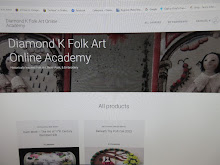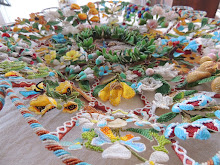Nice Work......... Early clothing and textiles are not only historical artifact, but works of art~ made by highly skilled needle workers......I purposefully do not say 'women', as there were plenty of men tailors, and in fact, most all clothing was made by men up to the 18th century. In those early days, one had to be member of a tailors guild to sew, and they did NOT allow women members until the first quarter of the 18th century..........but that's another subject~ I'm getting off track again.
Early clothing and textiles are not only historical artifact, but works of art~ made by highly skilled needle workers......I purposefully do not say 'women', as there were plenty of men tailors, and in fact, most all clothing was made by men up to the 18th century. In those early days, one had to be member of a tailors guild to sew, and they did NOT allow women members until the first quarter of the 18th century..........but that's another subject~ I'm getting off track again.
This little boy's dress is a feast for the eyes, if one looks close enough. This is circa early 1840's. Entirely hand stitched in very small, even stitches. For study today, I have pictured the back closing. The carved mother of pearl buttons have 4 holes, and are stitched on in yellow silk twist, in the pattern of 3 little bud flowers, all radiating up from the bottom hole~ very charming effect.

All seams are piped~ neck edge, the back skirting formed down into a v shape, and the curved back seams~ instead of just being stitched together, a bias strip has been folded, pressed and stitched into the seam along with the piping. This alone would have taken several hours of stitching~ I sew very fast(by hand only), and these 2 back seams would take me at least a day to stitch. Such a care has been made to make the back of this dress look just as nice as the front.
At a glance, the back closing looks to be of buttons.........but shoosh~ who would want to do up all those buttons as their child is hopping around ready to start their day????

This is the interior of the back opening. The buttons are just for show(an actually a statement of wealth~ as buttons were very expensive). You can see the bodice lining, neck binding and piping, and the row of brass hooks sewn in from the edge about 1.5" or so.
 Perfect even gathers at the skirting~ also known as gauging.
Perfect even gathers at the skirting~ also known as gauging.
 There are no metal eyes on the opposite bodice edge. The hooks fit neatly and securely into this cording that is stitched at the extreme edge~ right on the fold of the fabric. To the right, you can see a single thread crochet eye to catch the hook that keeps the button flap down nice and flat when the dress is done up.
There are no metal eyes on the opposite bodice edge. The hooks fit neatly and securely into this cording that is stitched at the extreme edge~ right on the fold of the fabric. To the right, you can see a single thread crochet eye to catch the hook that keeps the button flap down nice and flat when the dress is done up.

This is again the back, but this time, note the wide fancy sleeve cuff, and close fitting top cap? It was so common for clothing to be made with expandable waists and growth tucks sewn into the skirt hems for ease of letting out as the child grew.... But what about sleeves? Short sleeves would be no problem~ but how would a person adjust the fit of a long sleeve~ especially if they had some sort of fancy trim on the cuff, such as this one?
 Ahhhhh.......s.n.e.e.k.y! When the top sleeve cap is turned inside out, revealing the top of the sleeve, here is where an adjustment in length was made~ a tuck neatly hidden out of view.
Ahhhhh.......s.n.e.e.k.y! When the top sleeve cap is turned inside out, revealing the top of the sleeve, here is where an adjustment in length was made~ a tuck neatly hidden out of view.
 Next time, when you are reaching for that bottle of Clorox bleach to brighten up your whites.... maybe you should give it a little nuzzle of affection....or, dare I say a kiss!
Next time, when you are reaching for that bottle of Clorox bleach to brighten up your whites.... maybe you should give it a little nuzzle of affection....or, dare I say a kiss!











 Ahhhhh.......s.n.e.e.k.y! When the top sleeve cap is turned inside out, revealing the top of the sleeve, here is where an adjustment in length was made~ a tuck neatly hidden out of view.
Ahhhhh.......s.n.e.e.k.y! When the top sleeve cap is turned inside out, revealing the top of the sleeve, here is where an adjustment in length was made~ a tuck neatly hidden out of view.































